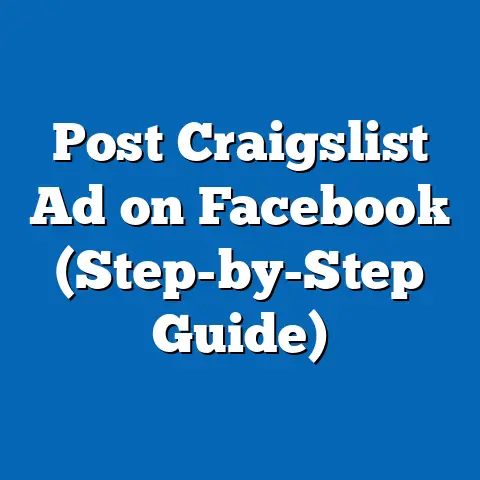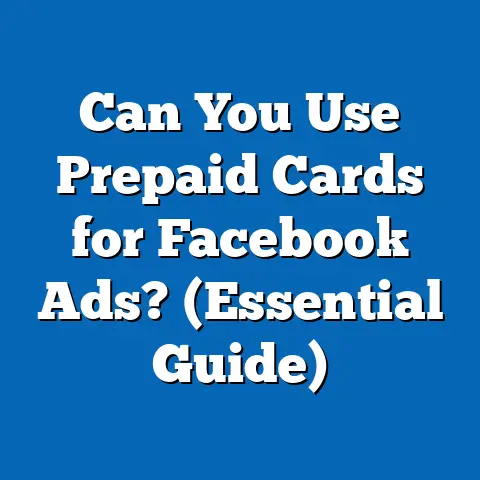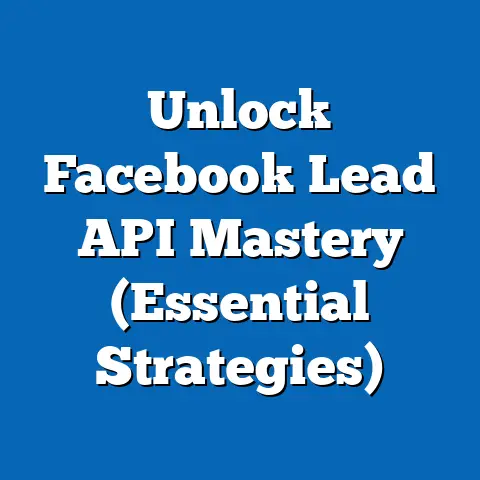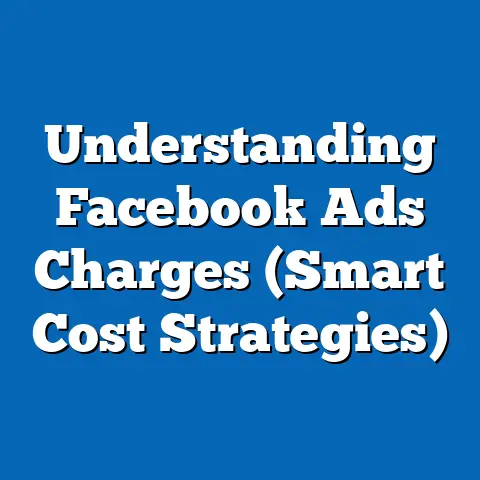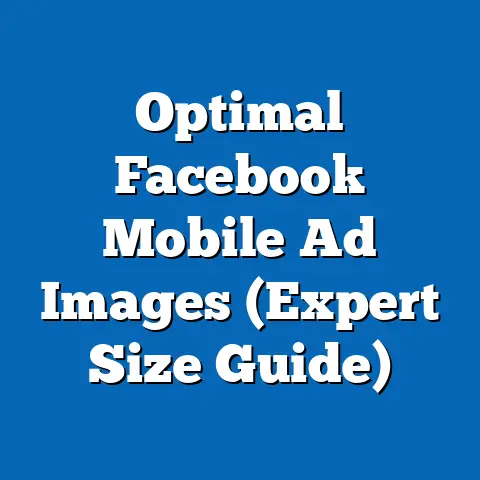Mastering Facebook Ads Withdrawals (Expert Strategies Revealed)
Facebook advertising can feel like navigating a complex maze. You set up your campaigns, target your audience, and launch your ads, hoping for a flood of conversions. But what happens when your ads aren’t performing as expected? That’s where mastering Facebook Ads withdrawals comes in. It’s not just about cutting losses; it’s about strategically reallocating your resources for maximum impact. In this guide, I’ll share my experiences and expert insights to help you navigate the world of Facebook Ads withdrawals, ensuring you’re always optimizing for the best possible ROI.
Think of it like this: I once had a client who was adamant about running a particular ad campaign, even though the data clearly showed it was underperforming. They were emotionally attached to the creative and the messaging. It took a lot of convincing and data analysis to finally get them to withdraw from that campaign and shift the budget to a higher-performing one. The result? A significant increase in conversions and a happier client. This experience taught me the importance of being objective and data-driven when making withdrawal decisions.
Expert Tip: Leverage Audience Insights for Effective Budget Adjustments
Before diving into the nitty-gritty, here’s a crucial tip: Leverage Facebook’s Audience Insights for effective budget adjustments. I’ve found that many advertisers overlook this powerful tool, but it’s a goldmine of information. Audience Insights provides you with a deep understanding of your audience’s demographics, interests, behaviors, and even their purchase patterns. By analyzing this data, you can identify which audience segments are most responsive to your ads and which ones are not.
For example, if you’re targeting a broad age range (say, 25-55), Audience Insights might reveal that the 25-34 age group is significantly more engaged with your ads than the 45-55 group. Armed with this knowledge, you can strategically withdraw budget from the less responsive segment and reallocate it to the more engaged one, immediately boosting your campaign performance. This level of granularity allows you to make informed decisions, rather than relying on guesswork.
1. Understanding Facebook Ads Withdrawals
So, what exactly do I mean by “Facebook Ads withdrawals?” It encompasses a range of actions, from minor tweaks to complete campaign shutdowns. Here’s a breakdown:
- Budget Adjustments: Reducing the daily or lifetime budget of a campaign or ad set. This is often the first step when you notice an ad isn’t performing well.
- Pausing Ads: Temporarily stopping an ad from running. This allows you to analyze the data, make changes, and relaunch the ad later.
- Pausing Ad Sets: Similar to pausing ads, but this action stops the entire ad set, which includes multiple ads.
- Ending Campaigns: Completely stopping a campaign and preventing any further ad spend. This is usually the last resort when a campaign consistently underperforms.
- Reallocating Funds: Moving budget from one campaign or ad set to another that is performing better. This is a proactive strategy to maximize your ROI.
Why would you consider withdrawing from certain ads? There are several reasons:
- Poor Performance: The most obvious reason. If an ad isn’t generating the desired results (e.g., low click-through rates, high cost per acquisition), it’s time to consider withdrawing.
- Changing Market Conditions: The market is dynamic. What worked yesterday might not work today. External factors like competitor activities, economic changes, or seasonal trends can impact ad performance.
- Shifts in Business Strategy: Your business goals might evolve. You might decide to focus on a different product line, target a new audience, or prioritize a different marketing channel.
- Inefficient Spending: Sometimes, ads might be generating clicks or impressions, but not converting into actual customers. This indicates inefficient spending and a need for withdrawal.
Takeaway: Understanding the different types of withdrawals and the reasons behind them is the first step in mastering this critical aspect of Facebook advertising.
2. Analyzing Performance Metrics
Knowing when to withdraw is just as important as knowing how. This is where performance metrics come into play. I rely heavily on these metrics to make data-driven decisions. Here are some key metrics to watch:
- Click-Through Rate (CTR): This measures the percentage of people who saw your ad and clicked on it. A low CTR indicates that your ad isn’t engaging enough.
- Interpretation: A CTR below 1% is generally considered low. Aim for a CTR of 2% or higher.
- Relationship to Other Metrics: A low CTR can lead to a high Cost Per Click (CPC), as you’re paying for impressions that aren’t resulting in clicks.
- Cost Per Click (CPC): This is the amount you pay each time someone clicks on your ad. A high CPC can quickly eat into your budget.
- Interpretation: A good CPC varies depending on your industry and target audience. Research industry benchmarks to see how your CPC compares.
- Relationship to Other Metrics: A high CPC can lead to a high Cost Per Acquisition (CPA), making your campaign unprofitable.
- Cost Per Acquisition (CPA): This is the amount you pay to acquire a customer or achieve a specific conversion goal (e.g., a purchase, a lead, a sign-up).
- Interpretation: Your CPA should be lower than the value of the acquisition. For example, if you’re selling a product for $50, your CPA should ideally be below $25 to ensure profitability.
- Relationship to Other Metrics: A high CPA can be caused by a low CTR, a high CPC, or a poor conversion rate on your landing page.
- Conversion Rate: This measures the percentage of people who clicked on your ad and completed a desired action (e.g., made a purchase, filled out a form).
- Interpretation: A good conversion rate depends on your industry and the complexity of the conversion process.
- Relationship to Other Metrics: A low conversion rate can negate the benefits of a low CPC, resulting in a high CPA.
- Relevance Score: This is a score from 1 to 10 that Facebook assigns to your ad based on its relevance to your target audience. A low relevance score indicates that your ad isn’t resonating with your audience.
- Interpretation: Aim for a relevance score of 7 or higher.
- Relationship to Other Metrics: A low relevance score can lead to a higher CPC and a lower CTR.
- Interpretation: A CTR below 1% is generally considered low. Aim for a CTR of 2% or higher.
- Relationship to Other Metrics: A low CTR can lead to a high Cost Per Click (CPC), as you’re paying for impressions that aren’t resulting in clicks.
- Interpretation: A good CPC varies depending on your industry and target audience. Research industry benchmarks to see how your CPC compares.
- Relationship to Other Metrics: A high CPC can lead to a high Cost Per Acquisition (CPA), making your campaign unprofitable.
- Interpretation: Your CPA should be lower than the value of the acquisition. For example, if you’re selling a product for $50, your CPA should ideally be below $25 to ensure profitability.
- Relationship to Other Metrics: A high CPA can be caused by a low CTR, a high CPC, or a poor conversion rate on your landing page.
- Interpretation: A good conversion rate depends on your industry and the complexity of the conversion process.
- Relationship to Other Metrics: A low conversion rate can negate the benefits of a low CPC, resulting in a high CPA.
- Interpretation: Aim for a relevance score of 7 or higher.
- Relationship to Other Metrics: A low relevance score can lead to a higher CPC and a lower CTR.
Example: Let’s say you’re running an ad campaign to promote a new e-book. You notice that your CTR is 0.5%, your CPC is $2, and your CPA is $10. This indicates that your ad isn’t engaging enough (low CTR), you’re paying too much for each click (high CPC), and you’re spending too much to acquire a lead (high CPA). In this scenario, it’s definitely time to consider withdrawing from this ad and making some changes.
Takeaway: Regularly monitoring these metrics and understanding their relationships will empower you to make informed decisions about when to withdraw from underperforming ads.
3. Strategic Budget Reallocation
Withdrawing from an ad isn’t just about cutting losses; it’s about strategically reallocating your budget to higher-performing campaigns. This requires a proactive approach and a keen eye for identifying opportunities.
Here’s how I approach budget reallocation:
- Identify High-Performing Campaigns: Look for campaigns that are consistently generating positive results (e.g., high CTR, low CPC, low CPA).
- Assess Potential for Growth: Can these campaigns scale? Is there room to increase the budget without diminishing returns?
- Analyze Audience Overlap: Are the high-performing campaigns targeting the same audience segments as the underperforming ones? If so, consider consolidating your budget into the campaigns that are resonating the most.
- Test New Audiences: Use the budget freed up from underperforming ads to test new audience segments. This can uncover new opportunities for growth and expansion.
- Optimize Ad Creative: Use the insights gained from your performance metrics to optimize your ad creative. Experiment with different headlines, images, and calls to action to improve engagement.
Methods to Assess Campaigns Worth Investing In:
- Lookalike Audiences: Expand your reach by targeting people who are similar to your existing customers. Facebook’s Lookalike Audiences feature is a powerful tool for finding new customers who are likely to be interested in your products or services.
- Interest-Based Targeting: Target people based on their interests, hobbies, and behaviors. This allows you to reach a highly relevant audience with your ads.
- Retargeting: Target people who have previously interacted with your website or Facebook page. Retargeting is a highly effective strategy for re-engaging potential customers and driving conversions.
Example: Let’s say you’re running two ad campaigns: one targeting a broad audience and another targeting a specific niche. You notice that the niche campaign is generating a significantly higher ROI than the broad campaign. In this scenario, it makes sense to withdraw budget from the broad campaign and reallocate it to the niche campaign. This will allow you to focus your resources on the audience segment that is most likely to convert.
Takeaway: Strategic budget reallocation is a continuous process that requires careful analysis and a willingness to adapt to changing market conditions.
4. The Role of A/B Testing in Withdrawals
A/B testing is a powerful tool for determining the effectiveness of different ads before making withdrawal decisions. By testing different variations of your ads, you can identify which elements are resonating with your audience and which ones are not.
Here’s how I use A/B testing:
- Identify Elements to Test: Focus on testing one element at a time (e.g., headline, image, call to action). This allows you to isolate the impact of each element on ad performance.
- Create Variations: Create two or more variations of your ad, each with a different version of the element you’re testing.
- Run the Test: Run the A/B test for a sufficient period of time (usually at least a week) to gather enough data.
- Analyze the Results: Compare the performance of the different variations and identify the winner.
- Implement the Winner: Implement the winning variation in your main campaign and continue to monitor its performance.
Best Practices for Conducting A/B Tests:
- Test One Element at a Time: This ensures that you can accurately attribute the results to the specific element you’re testing.
- Use a Control Group: Include a control group (the original version of your ad) to provide a baseline for comparison.
- Run the Test for a Sufficient Period of Time: This ensures that you gather enough data to draw meaningful conclusions.
- Use Statistical Significance: Use statistical significance to determine whether the results are statistically significant or simply due to chance.
Example: Let’s say you’re running an ad campaign to promote a new product. You’re not sure which headline will resonate best with your audience, so you decide to run an A/B test. You create two variations of your ad, one with the headline “Get 20% Off Your First Order” and another with the headline “Limited Time Offer: Don’t Miss Out.” After running the test for a week, you notice that the “Limited Time Offer” headline is generating a significantly higher CTR and conversion rate. In this scenario, you would implement the “Limited Time Offer” headline in your main campaign and continue to monitor its performance.
Takeaway: A/B testing is an invaluable tool for optimizing your ads and making informed decisions about when to withdraw from underperforming campaigns.
5. Case Studies and Real-Life Examples
To illustrate the concepts discussed above, let’s look at a few real-life examples of businesses that successfully managed their Facebook Ads withdrawals:
- Case Study 1: E-commerce Store
- Challenge: An e-commerce store was running a broad ad campaign targeting a wide range of interests. The campaign was generating a lot of impressions, but the conversion rate was low.
- Strategy: The store analyzed its performance metrics and identified that the campaign was underperforming because it was targeting too broad of an audience. They decided to withdraw from the broad campaign and reallocate the budget to a more targeted campaign focusing on specific product categories.
- Outcome: The targeted campaign generated a significantly higher conversion rate and a lower CPA, resulting in a substantial increase in ROI.
- Case Study 2: Local Restaurant
- Challenge: A local restaurant was running an ad campaign promoting a lunch special. The campaign was generating some traffic, but the restaurant wasn’t seeing a significant increase in lunch sales.
- Strategy: The restaurant conducted an A/B test to determine which ad creative was most effective. They tested different images and headlines, and they found that an image of their most popular dish with the headline “Delicious Lunch Specials Starting at $10” generated the best results.
- Outcome: The optimized ad campaign generated a significant increase in lunch sales, resulting in a positive ROI.
- Case Study 3: SaaS Company
- Challenge: A SaaS company was running an ad campaign to generate leads for a free trial. The campaign was generating a lot of leads, but the quality of the leads was low.
- Strategy: The company analyzed its lead data and identified that the campaign was attracting a lot of unqualified leads. They decided to withdraw from the campaign and reallocate the budget to a more targeted campaign focusing on specific industries and job titles.
- Outcome: The targeted campaign generated fewer leads, but the quality of the leads was significantly higher, resulting in a higher conversion rate and a lower CPA.
- Challenge: An e-commerce store was running a broad ad campaign targeting a wide range of interests. The campaign was generating a lot of impressions, but the conversion rate was low.
- Strategy: The store analyzed its performance metrics and identified that the campaign was underperforming because it was targeting too broad of an audience. They decided to withdraw from the broad campaign and reallocate the budget to a more targeted campaign focusing on specific product categories.
- Outcome: The targeted campaign generated a significantly higher conversion rate and a lower CPA, resulting in a substantial increase in ROI.
- Challenge: A local restaurant was running an ad campaign promoting a lunch special. The campaign was generating some traffic, but the restaurant wasn’t seeing a significant increase in lunch sales.
- Strategy: The restaurant conducted an A/B test to determine which ad creative was most effective. They tested different images and headlines, and they found that an image of their most popular dish with the headline “Delicious Lunch Specials Starting at $10” generated the best results.
- Outcome: The optimized ad campaign generated a significant increase in lunch sales, resulting in a positive ROI.
- Challenge: A SaaS company was running an ad campaign to generate leads for a free trial. The campaign was generating a lot of leads, but the quality of the leads was low.
- Strategy: The company analyzed its lead data and identified that the campaign was attracting a lot of unqualified leads. They decided to withdraw from the campaign and reallocate the budget to a more targeted campaign focusing on specific industries and job titles.
- Outcome: The targeted campaign generated fewer leads, but the quality of the leads was significantly higher, resulting in a higher conversion rate and a lower CPA.
Key Takeaways:
- Data-Driven Decisions: All three businesses made data-driven decisions based on their performance metrics and A/B testing results.
- Targeted Approach: All three businesses focused on targeting a specific audience segment with their ads.
- Continuous Optimization: All three businesses continuously optimized their ads based on their performance metrics and A/B testing results.
Takeaway: These case studies demonstrate the importance of analyzing your data, targeting your audience, and continuously optimizing your ads to maximize your ROI.
Conclusion
Mastering Facebook Ads withdrawals is a crucial skill for any advertiser. It’s not just about cutting losses; it’s about strategically reallocating your resources for maximum impact. By understanding the different types of withdrawals, analyzing your performance metrics, strategically reallocating your budget, utilizing A/B testing, and learning from real-life examples, you can ensure that you’re always optimizing your campaigns for the best possible ROI.
Remember, Facebook advertising is a continuous learning process. Be proactive in analyzing your ad performance, adjusting your strategies, and experimenting with new approaches. With the right mindset and the right tools, you can master Facebook Ads withdrawals and achieve your advertising goals. So, go ahead, take control of your ad spend, and start maximizing your ROI today!

